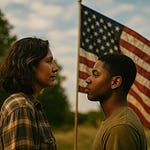There’s a quiet shift happening in America—one that no headline, op-ed, or talking head on cable news quite knows how to frame. It’s happening not in Washington, not on Twitter, but at gun counters, safety courses, and local shooting ranges.
The people buying guns don’t all look the same anymore. They don’t all vote the same. They don’t all worship the same, or love the same, or even believe the same things about America. But they’re showing up. Not in anger or rebellion—but in deep concern, and in quiet self-determination.
They are queer. They are trans. They are Black and Brown and immigrant. They are women who don’t trust the police to come in time. They are men who feel unsafe walking alone. They are people who believe in bodily autonomy—and are slowly realizing that civil rights don’t mean much without the ability to enforce boundaries.
And the thing is—these people aren’t buying guns to make a point. They’re buying guns because they feel vulnerable. Not metaphorically. Not symbolically. They are afraid. The safety net they thought they had—parades, brands, rainbow logos, corporate affirmations—has been revealed as temporary, conditional, and often hollow. It was always more radical chic than radical solidarity: a fashionable nod to inclusion without the hard infrastructure of protection.
Now that laws are shifting, protections are being revoked, and hate is being emboldened, many are realizing that much of what passed for inclusion was appeasement. It was good optics. It was performative. And it did not prepare anyone for what it feels like when the state turns cold—or when the crowd grows hostile.
They see what other Americans have long known: that governments can turn. That mobs don’t always need permission. That safety isn’t guaranteed, even in your own neighborhood. That real freedom means not having to wait for rescue.
This isn’t just a story about a new wave of gun owners. It’s also a story about a long-standing movement that has, for decades, been pushed to the margins—mocked, misunderstood, and legislated against.
We’ve seen assault weapon bans come and go, with arbitrary restrictions that made little practical sense. Glocks and AR-15s—two of the most common and reliable tools of civilian defense—were vilified and heavily regulated. In states like California, Gen 3 Glocks are the only approved models. High-capacity magazines are banned. AR-15s must be neutered with fixed magazines or bizarre workaround compliance kits. Many of these laws are still on the books, and they affect legal, peaceable citizens more than criminals.
The broader 2A community has watched the erosion of rights with increasing concern, even as other states have pushed in the opposite direction—adopting constitutional carry, permitless carry, and rolling back burdensome restrictions. This wasn’t always the case. In the 1980s, very few states offered broad carry rights. Now, more than half do.
Selfishly, yes—we see a moment of opportunity. As more communities begin to understand the purpose of armed self-reliance, as fear shifts from theoretical to personal, we see a chance to build something broader, stronger, and more enduring. We welcome anyone willing to take on the responsibility of arms, regardless of identity, politics, or background.
You don’t need to agree with us on every issue. But if you understand now that safety cannot be delegated, that rights must be exercised to be preserved, then we’re not enemies. We’re neighbors. We may not share flags or slogans—but we share a belief that you deserve the tools to protect what you love.
So yes, buy your AR. Buy your AKM if that’s your vibe. Rock that Makarov. Drag it up Soviet-style if that speaks to your soul—leather chest rig, post-Soviet surplus, and all. You’re not cosplaying tyranny. You’re preparing to resist it.
But here’s the caveat: don’t just buy a gun and toss it under your bed like it’s a magic talisman. You wouldn’t buy a violin and expect to play Carnegie Hall, and you shouldn’t buy a firearm and expect to be safe, competent, or responsible without training.
Start simple. Buy good enough. You don’t need to blow your savings on Gucci-tier gear. A used Glock 19, 26, or 27 and a basic AR, shotgun, or bolt-action rifle will cover nearly every civilian use case. Skip the red dot, skip the night vision—spend the extra money on training.
Take a class. Take two. There are women-only classes, beginner-friendly classes, and yes—LGBTQIA+ and trans-safe classes too. Spend money on ammo and range time. Learn how your tools work. Learn how you work under pressure. And most importantly, learn how to be safe.
We take that part very seriously. We don’t point muzzles at anything we don’t intend to destroy. We don’t keep fingers on triggers until we’re ready to fire. We chamber-check. We clear before we clean. We treat every firearm as if it’s loaded—always. These aren’t just rules. They’re a culture. And they keep us alive.
So if you’re newly considering gun ownership—not out of hatred, but out of love for your life, your community, your people—come on in. The water’s fine. The doors are open. And there are more people here who understand you than you might imagine.
We may look different. We may vote different. But under the weight of responsibility and the promise of liberty, we carry the same load.
Welcome.
tl;dr
The provided text, "DEI Meets 2A: Diversity, Equality, and Inclusion Under the Big-Ass Tent of the Second Amendment," explores a changing demographic in firearm ownership in the United States. It highlights how traditionally marginalized groups, including queer, trans, Black, Brown, and immigrant individuals, are increasingly acquiring firearms out of feelings of vulnerability and a desire for self-protection, not to make a political statement. The author argues that performative inclusion from institutions has failed to provide real safety, leading these individuals to understand that civil rights are strengthened by the ability to defend oneself. The piece also touches upon the broader Second Amendment community's perspective, welcoming these new gun owners and encouraging responsible training and safe practices, emphasizing that the common goal of self-preservation transcends political or identity differences. Ultimately, it advocates for armed self-reliance as a means of true freedom and safety in an uncertain world.













Share this post